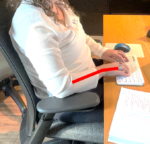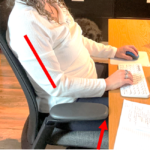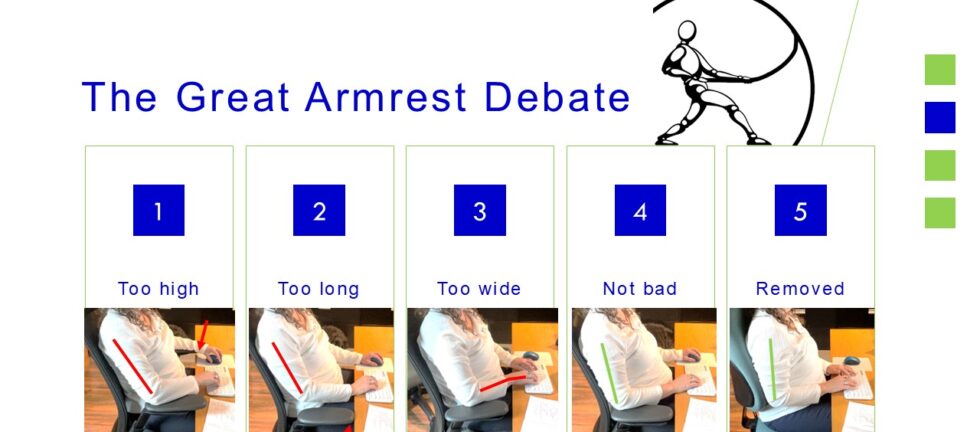When choosing an ergonomic office chair, armrests are often seen as a must-have feature. But are they truly necessary for comfort and productivity—or could they do more harm than good?
The CSA Office Ergonomics Standard suggests that “A competent person in ergonomics shall determine if a work chair without armrests is appropriate.” How do we do that?
What are armrests supposed to do?
Armrests should be designed to support your arms in a neutral posture. This means your upper arms should hang vertically, naturally by your sides, elbows close to your body, and forearms parallel to the floor. The goal is to minimize muscle strain in your shoulders and arms.
If armrests are designed with sufficient adjustability to permit a worker to sit at the computer and adjust just under the horizontal forearms while the upper arms hang vertically – hurray! They might be useful. I might add that, in this position, the muscle load on the shoulder and arm muscles is very low, so the need for armrests is negligible. In 35 years of practice, I have never encountered someone who was working in this position, and asked for better armrests for typing. The motivation behind an armrest request is usually arm fatigue.
When do armrests hurt more than they help?
Armrests are not “ergonomic” when they:
 Cause contact pressure
Cause contact pressure
Sometimes the armrests are made of very firm material. The user rests the elbow or forearm on the armrest and experiences pain or even numbness, because the weight of the arm is not evenly distributed over the surface of the armrest. More “squishy” material will help, but the problem often occurs because the user can’t get the armrest adjusted under the forearm.
- Cause the shoulders to be raised or “abducted” (winged out to the side)
This happens when the armrests are not adjustable, so the user lifts the elbows up and outward to place them on the armrests. What’s the harm? If the armrests are bearing the weight of the arm, then the muscles don’t have to work to hold you in that position. However, every time you need to move your arm, say to switch between keyboard and mouse, you’re starting from a position that DOES require muscle activation.
- Cause the wrists t
 o bend
o bend
The other problem with that “winged out” posture, seen when the armrests are too far apart, is that it makes the wrists bend. Because the elbows are far apart, the hands must converge at the keyboard, and the wrists must bend. This is not an ideal typing posture.
- Confine you to your chair
You might have heard that movement is key to preventing discomfort for office workers. If you’re lucky enough to have armrests that adjust perfectly, you probably have to adjust them every time you stand up. (I would, anyway, because my hips are wider than my waist. Sigh…) The problem with a feature that has to be adjusted every single time the user sits down is that it doesn’t get used – the armrests get left in the “wide” position. Some workers have a tendency to lean on one armrest, which can create a very awkward back posture.
- Cause you to reach

This reach is the biggest issue with armrests, and the most common reason for having them removed. Many armrests can’t be adjusted to avoid banging into the desk or keyboard tray, when the user pulls the chair close to the desk. Even a very slight forward reach can cause the shoulder muscles to activate, causing fatigue in the shoulders, upper back, and neck. Try for yourself: Tuck one elbow close to your body and use the other hand to feel your shoulder. The muscle should be soft. Now move the elbow very slightly forward; you should feel the muscle firm up as it’s called into action. That little bit of effort, over the course of the day, causes fatigue. Fatigue leads to pain. Arranging the workstation and adjusting the chair to eliminate the reach should always be the priority when addressing this type of discomfort.
Can we do without them?

If your armrests will adjust to support you, or they will adjust so they don’t get in your way, by all means, keep them! While many ergonomists, myself included, often remove armrests due to their limitations, they can benefit users with specific needs, such as those with mobility challenges.
Do you really need armrests?
Some people do need armrests, including:
- People who need assistance getting in and out of the chair. If you have hip or knee problems that make it difficult for you to get in and out of the chair, you might use the armrests as support.
- People who, due to their body size or other factors, cannot type and mouse with the upper arm vertical. A large abdomen might prevent a user from sitting close to the keyboard. In this case, the armrests support a necessarily-awkward arm posture.
 If you do need armrests, make sure that the chair you select has the features that you need. The cost to upgrade armrests so they will adjust effectively can be significant, so be sure that you’ll be better off with them than without.
If you do need armrests, make sure that the chair you select has the features that you need. The cost to upgrade armrests so they will adjust effectively can be significant, so be sure that you’ll be better off with them than without.
The debate over armrests is not simple. While they can provide support for some people, they aren’t a one-size-fits-all solution. Evaluating your specific needs and work environment is key to determining whether armrests truly belong on your chair. We can help.
Office Ergo Assessments (in person and remote)
Office Ergo training for workers (1-1.5 hours)
Virtual Office Ergo training (2 hours)


